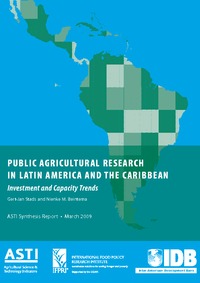Authors:
Stads, Gert-Jan; Beintema, Nienke
Year:
2009
Publisher
Agricultural Science & Technology Indicators (ASTI); International Food Policy Research Institute (IFPRI); and Inter-American Development Bank (IDB)
Back to:
In 2006, LAC as a whole employed more than 19,000 FTE researchers in agriculture and invested $3.0 billion in agricultural R&D (in 2005 constant prices), which corresponds to 1.14 percent of the region’s total agricultural output. Nevertheless, 70 percent of this total was spent by just three countries: Argentina, Brazil, and Mexico. Were these “big three” countries excluded, the region’s agricultural R&D investments as a percentage of AgGDP would be substantially lower (0.72 percent). Regionwide investments grew by 1.1 percent per year during 1981–2006, but this average masks significant differences over time and among countries. During 1996–2006, agricultural research spending in countries like Argentina, Costa Rica, and Uruguay rose markedly, whereas expenditures in countries like Chile, El Salvador, Guatemala, Honduras, and Paraguay contracted. Brazil, the region’s largest country, also experienced a modest decline in its agricultural R&D investments since the mid-1990s largely due to reduced spending by the country’s state government agencies in recent years.
LAC’s human resource capacity in agricultural R&D shows similar diversity across countries. Argentina, Brazil, and Mexico each have large and comparatively complex systems employing thousands of scientists, whereas capacity in the countries of the Caribbean and Central American is understandably much smaller. Overall, entities conducting agricultural R&D in the LAC region have become increasingly diversified in recent decades, with the INIAs occupying a progressively lower share of total research staff numbers. Large national differences in the average qualifications of agricultural scientists are also present; nonetheless, qualification improved overall in most countries in the past decade. A worrying trend, however, is that the pool of scientists is aging and some countries have failed to address this with initiatives to hire and train younger scientists.
Most agricultural R&D in LAC is funded by national governments, but sources differ widely across countries. Commodity taxes on the sale of production or exports have become popular in many countries, especially Colombia and Costa Rica, and competitive funding mechanisms are also gaining popularity in a large number of countries. Donor dependency for the LAC region as a whole is much lower than in Sub-Saharan Africa, although it remains very high in countries like Nicaragua and Honduras. Internally generated resources and private funding play an important role in financing agricultural research in the region as well. In addition to financing research directly, national and multinational private enterprises also carry out their own research in some countries; the exact share of private-sector involvement in agricultural R&D in LAC, however, is difficult (if not impossible) to measure.
Beintema and Pardey (2001) stated that the most worrying trend in agricultural R&D in LAC was the apparent bifurcation of agricultural research. More recent data to 2006 confirm that the gap between the region’s low- and middle-income countries has in fact widened. Some of the poorer, agriculturedependent countries—such as Guatemala, El Salvador, and Paraguay—experienced sharp cuts in their agricultural research expenditures and intensity ratios over the past decade, while some of the more economically advanced countries (such as Argentina and Mexico) experienced growth. It is becoming increasingly clear that the region’s low-income countries are slipping behind in their ability to generate new technologies and varieties. Moreover, most of the region’s poorest and technologically most challenged countries are in tropical zones, putting them at a disadvantage compared with their more advanced neighbors in temperate zones, which gain large benefits from the spillover of technologies and varieties generated in high-income countries with similar agroclimatic conditions.
Sustainable financial support for agricultural R&D is crucial in all countries of the region, not only in support of revenue-generating export crops, but also in support of much-needed food crops and, more generally, development initiatives to alleviate rural poverty. If the region is to achieve food security, reduce poverty, and compete in an increasingly competitive global market, strong political support for agricultural R&D is called for in addition to financial support, as is greater integration of agricultural R&D systems both within and among countries.

